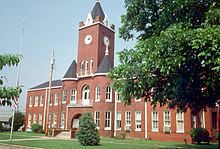Founded December 29, 1841 Area 1,761 km² | Named for John Coffee Congressional district 2nd Website www.coffeecounty.us Population 50,938 (2013) | |
 | ||
Rivers Pea River, Double Bridges Creek, Cowpen Creek Points of interest Boll Weevil Monument, John Henderson Family Pa, Fun Factory, Enterprise Parks & Recreation, Wiregrass Animal Kingdom | ||
Goodman school coffee county alabama 1930 s
Coffee County is a county of the U.S. state of Alabama. As of the 2010 census, the population was 49,948. Its county seat is Elba. Its name is in honor of General John Coffee.
Contents
- Goodman school coffee county alabama 1930 s
- Map of Coffee County AL USA
- History
- Geography
- Adjacent counties
- Demographics
- Cities
- Towns
- Notable people
- In popular culture
- References
Map of Coffee County, AL, USA
Coffee County comprises the Enterprise, AL Micropolitan Statistical Area, which is also included in the Dothan-Enterprise-Ozark, AL Combined Statistical Area. The Coffee County Courthouse is located in Elba.
History
The land in Coffee County was originally part of Dale County, which was incorporated in 1824. Coffee County was formed from the western part of Dale County on December 29, 1841. It was named after John R. Coffee, a hero in the Creek War of 1813—14. The first county seat was in Wellborn. After the courthouse was destroyed by fire in 1851, the county seat was moved to Elba.
On March 10, 2009, in Kinston, Michael McLendon began a shooting rampage that continued onward into the Geneva County towns of Samson and Geneva. Ten people were killed and six more were wounded before McLendon committed suicide.
Geography
According to the U.S. Census Bureau, the county has a total area of 680 square miles (1,800 km2), of which 679 square miles (1,760 km2) is land and 1.5 square miles (3.9 km2) (0.2%) is water.
Adjacent counties
Demographics
As of the census of 2010, there were 49,948 people, 19,849 households, and 13,837 families residing in the county. The population density was 74 people per square mile (29/km2). There were 22,330 housing units at an average density of 33 per square mile (12.7/km2). The racial makeup of the county was 74.7% White, 16.7% Black or African American, 1.3% Native American, 1.3% Asian, 0.2% Pacific Islander, 3.2% from other races, and 2.5% from two or more races. 6.4% of the population were Hispanic or Latino of any race.
There were 19,849 households out of which 30.1% had children under the age of 18 living with them, 52.6% were married couples living together, 12.9% had a female householder with no husband present, and 30.3% were non-families. 25.4% of all households were made up of individuals and 9.8% had someone living alone who was 65 years of age or older. The average household size was 2.49 and the average family size was 2.98.
In the county, the population was spread out with 24.2% under the age of 18, 8.6% from 18 to 24, 27.1% from 25 to 44, 25.7% from 45 to 64, and 14.4% who were 65 years of age or older. The median age was 37.6 years. For every 100 females there were 97.7 males. For every 100 females age 18 and over, there were 101.3 males.
The median income for a household in the county was $42,253, and the median income for a family was $54,929. Males had a median income of $41,635 versus $29,082 for females. The per capita income for the county was $22,797. About 14.1% of families and 17.2% of the population were below the poverty line, including 26.4% of those under age 18 and 13.4% of those age 65 or over.
Cities
Towns
Notable people
In popular culture
The county is referred to in Joe David Brown's 1971 novel Addie Pray, which inspired the movie Paper Moon.
